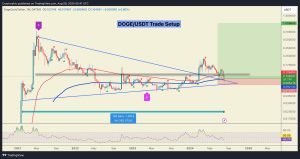Using Technical Analysis to Navigate Unpredictable Markets
Unpredictable markets can be overwhelming, even for experienced traders. Price swings come fast, and without a clear strategy, it’s easy to make decisions based on emotion rather than logic. This is where technical analysis becomes an important tool, it helps you make sense of market movements and make informed trading decisions, even when everything seems uncertain.
The Basics of Technical Analysis
At its core, technical analysis is about using historical price data and trading volume to forecast future price movements. Instead of trying to predict the market based on news or economic data, you’re focusing on patterns, trends, and key levels that show how the market has behaved in the past.
One of the simplest but most powerful tools is the moving average. A moving average smooths out price data over a set period, allowing you to see the broader trend without getting distracted by short-term fluctuations. For example, the 50-day moving average can show you the overall direction of a stock or crypto asset, while the 200-day moving average helps spot longer-term trends.
In unpredictable markets, the moving average is your friend. When prices are choppy and erratic, the moving average gives you a clear signal of the general direction, helping you avoid impulsive decisions based on day-to-day volatility. For more strategies on leveraging technical analysis in specific scenarios, check out this short-term trading guide, where you’ll find additional insights to help you refine your trading skills in any market condition.
Spotting Trends and Reversals
One of the key goals of technical analysis is to identify when a market is trending and when it’s likely to reverse. Markets don’t move in a straight line, contrary there are always ups and downs, and the ability to spot these turns can make or break a trade.
When a market is trending, trendlines become a helpful tool. Drawing a line that connects the lows in an uptrend or the highs in a downtrend helps you visualize the path of least resistance. If the price stays above a trendline, you know the market is still moving in the same direction. If it breaks below, it may be time to reevaluate your position.
To spot potential reversals, look for signals like candlestick patterns. Patterns such as the hammer or engulfing pattern can indicate that a market is losing momentum and could be ready to turn in the opposite direction. For example, a hammer candlestick appearing after a downward trend can signal that sellers are losing strength and buyers might take over soon.
Using Indicators to Confirm Your Strategy
While spotting trends and reversals is important, you need more than one data point to make a strong trading decision. This is where technical indicators come in. Indicators like the Relative Strength Index or Bollinger Bands can give you additional confirmation that the trend you’re seeing is valid.
The RSI measures whether an asset is overbought or oversold. In unpredictable markets, this is particularly useful for avoiding trades that are likely to reverse soon. For instance, if the RSI shows that an asset is overbought (above 70), it may be time to prepare for a potential pullback.
Bollinger Bands measure price volatility by plotting bands around a moving average. When the price touches or moves outside these bands, it often signals that a reversal is near. In volatile markets, Bollinger Bands help you gauge whether the price is stretching too far in one direction and may be ready to snap back.
Using multiple indicators together gives you a clearer picture of the market’s behavior. When your indicators line up, it’s a strong signal that your analysis is on the right track.
Managing Risk with Technical Analysis
Unpredictable markets come with higher risks, so managing your exposure is crucial. Technical analysis isn’t just about finding opportunities—it’s also about minimizing risk.
One effective way to manage risk is by using support and resistance levels. Support is a price level where an asset tends to stop falling, while resistance is where it tends to stop rising. By identifying these levels, you can set more informed stop-loss orders to protect yourself if the market moves against you. A stop-loss order automatically closes your position if the price falls below a certain point, helping you cut losses before they snowball.
Additionally, trading smaller positions during times of high volatility can help protect your portfolio. In unpredictable markets, it’s better to take smaller, more calculated risks than to go all-in and hope for the best.
Staying Disciplined in Unpredictable Markets
Technical analysis provides the tools to make better decisions, but it’s up to you to stay disciplined. In unpredictable markets, it’s easy to get caught up in fast price movements and lose sight of your strategy. The key is to stay patient, stick to your analysis, and avoid making trades based on emotion or FOMO.
When the market seems chaotic, returning to your technical indicators and strategy will help you maintain a level head. Trust the signals and data rather than reacting impulsively to every price move.
Conclusion
Navigating unpredictable markets doesn’t have to feel like guesswork. By using technical analysis, you can cut through the noise and make more informed trading decisions. Whether you’re spotting trends, using indicators, or managing risk, the right tools can help you turn market volatility into opportunity.
Post Views: 110








